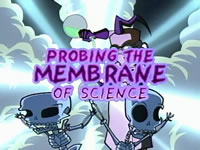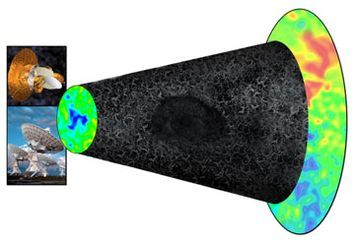
And it’s time once again for our tour of interesting and weird science bits.
This time out we start with the most science fictional story I’ve seen in a long time: methane ice worms!
From the story:
A team of university scientists using a mini research submarine on a NOAA-funded research cruise has discovered, photographed, and sampled what appears to be a new species of centipede-like worms living on and within mounds of methane ice on the floor of the Gulf of Mexico, about 150 miles south of New Orleans.
…
“The old view that the deep sea bottom is a monotonous habitat needs to be discarded. These worms are the major players in a new and unique marine ecosystem,” said expedition Chief Scientist Charles Fisher, an associate professor of biology at Penn State
So, new life-form, surviving in environment previously thought uninhabitable is pretty cool all by itself, but when you see the picture of these things, that’s when it really gets science fictional. Brace yourself and click here for the image.
![]()
 Well, that’s one possible horror story setup. Here’s another: Something ate a giant piece of the universe!
Well, that’s one possible horror story setup. Here’s another: Something ate a giant piece of the universe!
University of Minnesota astronomers have found an enormous hole in the Universe, nearly a billion light-years across, empty of both normal matter such as stars, galaxies and gas, as well as the mysterious, unseen “dark matter.” While earlier studies have shown holes, or voids, in the large-scale structure of the Universe, this new discovery dwarfs them all.
There could be lots of rational explanations, but the quote that “What we’ve found is not normal, based on either observational studies or on computer simulations of the large-scale evolution of the Universe,” makes me feel somewhat justified in imagining all kinds of epic scale pulp science fictional explanations for what happened to result in that void. It could be anything from a breakdown in Logopolis to the exercise of the Darkvoid device. (On the other hand, current models aren’t all that great, and as scientific folk we shouldn’t be too tightly tied to them.)
Something is in there… and the day is approaching when it will come out. Duh-duh-DUH!
![]()
Now let’s set aside horror for a moment, let’s look at another potentially very cool bit of hoary SF that might just turn out to be actual science: inorganic life.
I got this one from hard SF author Peter Watts:
Okay, now here’s a paper to kick your paradigms a little off-kilter: self-replicating, mutating complex structures built from inorganic dust, kick-started into a form of rudimentary “metabolism” by charged plasmas.
For want of a better word, Life. Inorganic life. Spawned from starting conditions reasonably common in deep space, if I’m to believe the commentary.
If I’m reading this correctly it not only opens the door to inorganic life, but also starts to make a lot of other Sfnal bits (like the “living energy” creature) start to seem plausible.
![]()
We’re also getting closer and closer to the old datacube idea. When I’m seriously reading about us making the jump from dual-layer optical discs that can store around 8Gb to 200-layer optical discs that can hold 1000Gb, it’s not too hard to imagine another such step or two taking us from the disc to the cylinder that can hold ALL THE DATA.
But let’s set that aside for a moment and just look at what we might be able to buy at the local office supply store in a couple of years: a 1TB recordable disc. I’m still trying to understand what it really means to have a TB on my desk
Think about it: We’ve long been into the post-scarcity world for text. I have thousands of books in my house, but I could fit all the text from all of them onto (at most) a couple of discs. I can easily carry around with me more text than I could possibly read in my life. This issue is not capacity, it’s finding the stuff I want, and then finding the time to read it.
For audio, we’re crossing that threshold. Carrying 80Gb around with me means I can have instant access to all the music I’m likely to want, and I can still have a few months worth of audiobooks/lectures/podcasts/whatever. Carrying around 1TB is a whole different game. If you fill 1TB with high quality stereo audio recordings in a lossy format like say 192kb/s MP3, you are measuring the listening time in years, and that’s assuming non-repeating play, 24/7. Obviously for music we would be past the point where you can fit all the music you will every listen to into one small space. Hell, even something non-repeating like say audio books, unless you’re listening to to it 24/7, your lifetime supply will fit into (at most) a couple of TB. For audio we’re in a post-scarcity world.
And video is probably soon to follow. A decent DIVX video encoding of an hour of HD TV can be crushed into about 1/3 of a GB. That means I can fit roughly 3000 hours into a TB. Storage is no longer the issue: the issue is finding 3000 hours of video worth watching, and finding the time to actually watch it.
Of course part of the response to the capacity increase will be waste. Someone will become convinced that ten tracks sampled independently at 196Khz with a resolution of 1024 bits will sound better than “CD quality”
What might be even more interesting is the bandwidth issue. It’s one thing to have a 1TB disc, but it’s a whole other thing to try to get the information on it to someone else over a narrow network pipe. Let’s say I’m in an office with gigabit ethernet: if I can get an ideal pipe between two machines that completely uses the entire bandwidth (which I can’t), it would still take hours to move one disc worth of data. In a more realistic scenario, it would take days. And that’s inside a single office with high end infrastructure. If I’m still struggling with a cable modem connection that maxes out around 100K/s on upload, then moving one disc worth of data is going to take… well do the math.
1 Tb = 1024 * 1024 * 1024 Kb = 210 * 210 * 210 Kb = 230 Kb
So, let’s assume 128Kb/s (or 27Kb/s) upload speed for simplicity. That means uploading 1 TB will take 230 / 27 seconds, or 223 seconds. That’s 8 388 608 seconds. 139 810 minutes. 2330 hours. Or, around 97 days.
Obviously unless there’s a very drastic improvement in bandwidth
And that’s before we even start to talk about other uses people will find for storage capacity now that it’s truly post-scarce. The idea of a high quality lifelog with high resolution video and full quality multi-channel sound, for example, is a lot more real in a world where where 1TB fits on a disc. Sure, one disc won’t hold a whole life log, but you’d be changing discs less often than you now charge your cell phone. And, of course, storage capacity will continue to grow. There are going to be tons of applications that used to be storage-bound that are suddenly possible, and tons more that no one will have conceived of yet.
Wow, I got on a bit of a tear there, didn’t I? Well, like I said, I’m still trying to figure out what it means.
![]()
As a reward for anyone who made it down this far, we can go back to what I think of as a real horror scenario.

